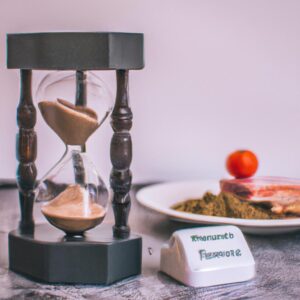Eating Healthy Doesn’t Have to Break the Bank: Smart Shopping & Meal Planning

Introduction
Eating healthy doesn’t have to mean breaking the bank. You can enjoy delicious, nutritious meals and snacks without spending a fortune. With a little meal planning and smart grocery shopping, you can make healthy eating on a budget a reality.
This guide is designed to help you achieve your health and nutrition goals while not overspending. It will provide an overview of the basics of healthy eating on a budget, share strategies for smart grocery shopping, explain meal planning principles, offer tips and shortcuts, and provide recipes that are both affordable and delicious.
Let’s begin by understanding the basics of eating healthy on a budget.
Understanding the Basics of Eating Healthy on a Budget
Eating healthy on a budget is achievable and shouldn’t be dismissed as impossible. We all want to eat nutritious meals without spending a fortune, so developing a meal plan is key to making sure you get the best value for your money while still enjoying delicious and healthy meals. Here we will discuss some basics of healthy eating and how to tailor it to suit your budget.
Whole-foods are what you should strive to include in your diet. These are foods that are as close to their natural state as possible, meaning they are unrefined, minimally processed and don’t contain artificial additives or preservatives. Examples include unprocessed grains, fruits, vegetables, nuts, legumes, and lean proteins like fish, turkey, and eggs. Not only do whole-foods contain essential vitamins and minerals, they also provide fiber that helps with digestion and promotes good gut health.
Portion control is a major consideration when planning meals on a budget. This means eating appropriate sized servings of whatever you’re having – not too much, and not too little. When it comes to portion sizes, make sure you’re not overeating. As well as avoiding wasting food, this will also help you stick to your budget, as you’ll have fewer leftovers that you won’t use. And if you are eating out, remember that you can always split a meal or take home leftovers. This way you’ll be able to enjoy a restaurant meal without breaking the bank.
In light of the discussions on whole-foods and portion control, how can one fit their meals into a budget? Start by looking for lower-cost alternatives when shopping. Frozen foods often provide quality ingredients for less than their fresh counterparts, and canned goods can be great for stocking up on items like beans and tomatoes that have a long shelf-life. Other cost saving tips include buying in season, bulk buying and making sure you plan meals that coordinate with any deals on groceries.
Shopping Strategies for a Healthy Eating Budget
As we have discussed, eating healthy on a budget requires careful planning and smart shopping. By following some simple strategies, you can make sure that you are always getting the most nutrition out of your food budget.
One way to maximize savings when grocery shopping is by buying in season. In-season fruits and vegetables tend to cost less than those that are out of season, so try to build meals around seasonal produce.
Another great strategy is to buy in bulk, especially for staples. Items such as beans, nuts, grains, and pasta can be purchased in large quantities and can go a long way in nourishing meals. Just remember that if you are stocking up on perishable items, you should try to use them up fairly quickly in order to avoid wastage.
Finally, it is worth scoping out deals on groceries. Whether it’s discounted meat, shipping specials or coupons, looking out for price slashes and advertisements could save you a fortune on your weekly food shop.
Meal Planning Principles
Planning nutritious and delicious meals while staying within your budget can be a challenge. To help you get started with meal planning, let’s discuss some principles that will keep you on track and keep money in your pocket.
Eat Whole Foods
The cheaper the food is, the more likely it has been processed and contains added sugars, unhealthy fats, and salt. You can save money over time by building meals around whole foods like legumes, grains, fresh produce, and lean meats. You can balance them with frozen fruits and vegetables, eggs, low-fat dairy, and nuts.
Choose Nutrient-Rich Foods
Choose foods that also offer a lot of nutrition for the price. Some nutrient-rich foods include potatoes, sweet potatoes, squash, spinach, kale, bananas, apples, oranges, unprocessed grains such as oats, quinoa, millet, and farro, and legumes like lentils, chickpeas, and black beans.
Be Mindful of Portions
It’s important to be mindful of portion sizes. Eating more than you need can quickly add up in calories and food costs. Portion control will help maximize the value of your food budget and help you stay in shape, too.
Plan Ahead
Start by creating a meal plan for the week. This will help you stay organized and avoid waste. A meal plan also helps you buy only the groceries you need for the week which helps reduce food costs.
Get Creative
Don’t be afraid to experiment with new ingredients and recipes. Making sure you choose nutritious and affordable ingredients can help you stretch your budget and create interesting dishes. Don’t forget to look up recipes online and in cookbooks to help get you started.
Shop around for Groceries
Find out where you can get the best prices for ingredients. Don’t just stick to the same store or brand for all your groceries. Checking out different stores or shopping online can help you find better prices. You could also look into subscription boxes that offer discounted groceries.
Meal Planning Tips and Shortcuts
Your meals don’t have to be complicated or expensive to be delicious and nutritious. The key is to be smart when meal planning and grocery shopping. Here are some tips and tricks to help you save time and money while maintaining healthy eating habits.
Grocery Shopping on a Schedule
Setting a regular schedule for grocery shopping helps ensure you are buying only what you need, and saves time and energy. Decide when you will be shopping (weekly, bi-weekly, or monthly), make a list ahead of time, and stick to it.
Plan Ahead with Meal Prep
Planning your meals ahead of time is essential for budgeting and staying healthy. Make a list of meals you plan on making for the next week or month, and make sure to factor in leftovers. Do a bit of meal-prepping before you go grocery shopping so you are ready to cook when you get home.
Batch-Cooking for Leftovers
Batch-cooking is a great way to save time in the kitchen. Make large portions of healthy meals, such as casseroles, soups, and stews, and store them in portion size containers. Having leftovers on hand will make it easy to put together nutritious meals quickly, without having to venture to the grocery store.
Freezing Meals for Later
Freezing individual portions of your favorite meals is a great way to ensure that you always have quick and easy options available. Place cooked food into freezer-safe containers and label them with the date and meal. This makes it easy to find and thaw delicious meals without having to resort to takeout.
Recipes for Healthy Eating on a Budget
Cooking on a budget can seem intimidating. But with a bit of creative thinking, you can create delicious and nutritious meals that don’t break the bank. Here are seven recipes, plus variations, that use inexpensive ingredients to deliver maximum flavour and nutrition.
- Lentil Shepherd’s Pie: This traditional British dish is packed with protein-rich lentils, vegetables and cheese. It’s easy to make ahead and reheat for a tasty, budget-friendly meal.
- Vegetable Curry: Fragrant spices, hearty vegetables and nutty grains make this Indian-inspired curry a family favourite, all made in one pot for fuss-free meal times.
- Teriyaki Bowl: A nourishing bowl of steamed vegetables and carbs topped with a homemade teriyaki sauce. So tasty and wholesome you won’t miss takeout nights.
- Pasta Primavera: This classic Italian-American dish combines seasonal vegetables and noodles in a garlic and herb-infused tomato sauce.
- Quinoa Salad: A filling meal-in-one that is perfect for lunch or a side dish. The nutty quinoa is combined with juicy vegetables and dressed with a flavourful vinaigrette.
- Chickpea Burgers: Delicious and nutritious veggie burgers made with chickpeas, breadcrumbs and fresh herbs. Serve in buns or enjoy as is with a salad or fries.
- Stir-fry: Whip up a quick dinner of colourful vegetables tossed in your favourite sauce. Make it gluten-free by using tamari instead of soy sauce.
These recipes are just the start of your budget-friendly cooking journey — have fun experimenting with different flavours and ingredients to find new favourite meals!
Wrapping Up Healthy Eating on a Budget
You have now learned the basics of eating healthy and budget-friendly meals. We have gone into the principles of meal planning, shopping strategies and tips for making it easier and faster. Finally, we shared seven recipes that are nutritious and budget-conscious.
Eating healthily on a budget requires understanding and mindfulness. Every time you go to the grocery store, you should be aware of your budget and be creative in the way you shop. Meal planning is essential to economizing your grocery list and cooking ahead will save time and money. Utilize strategies like buying in bulk and looking for deals in order to maximize savings.
Remember that eating healthy doesn’t have to be expensive! With the right meal planning and grocery shopping strategies, you can easily maintain a healthy diet while still staying within budget.
comments: 0





